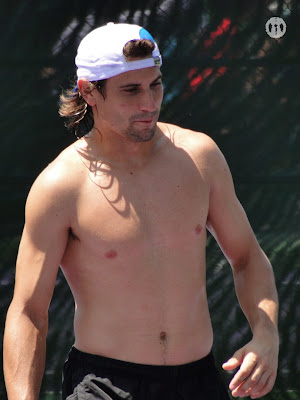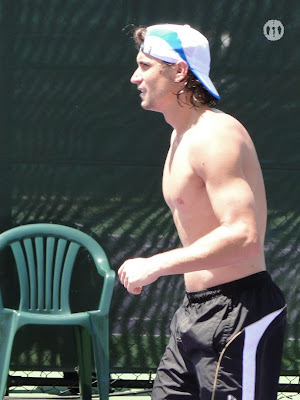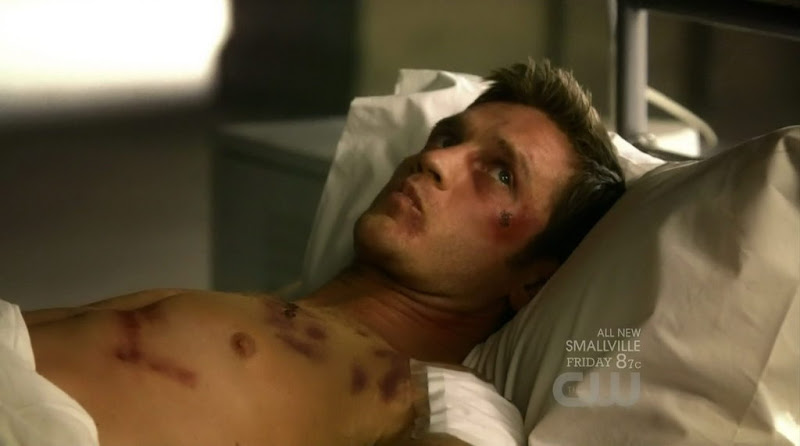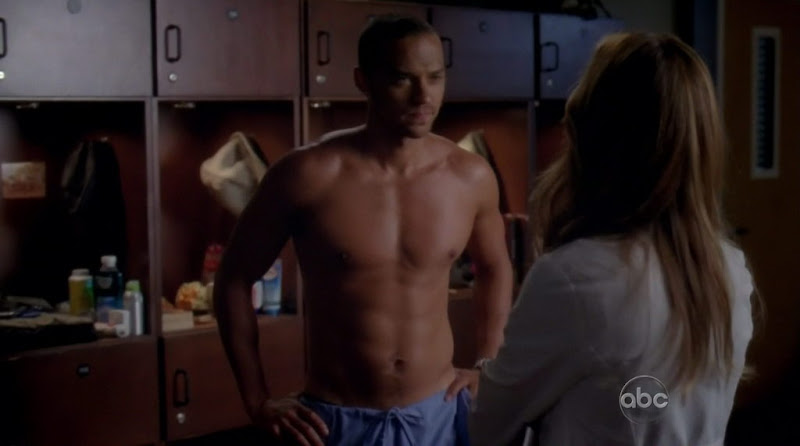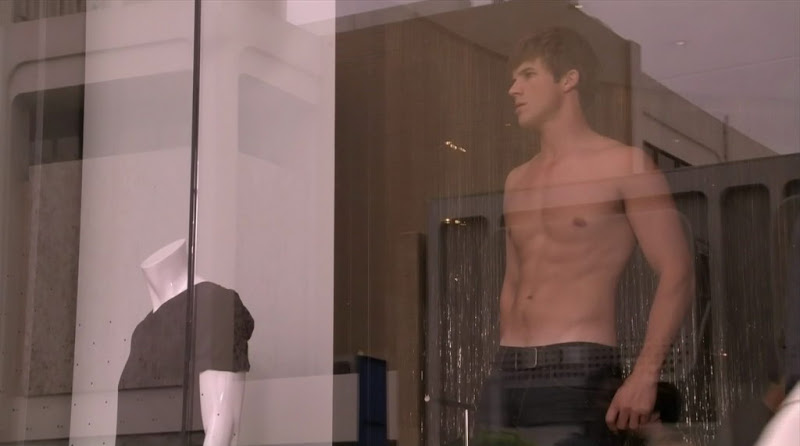Jeremy Davidson is shirtless on the episode "An Ideal Husband" of Brothers and Sisters. He's happy in bed with Kitty in the beginning of this episode and they broke up in the end. I don't understand the writers but I thank them for making Jeremy shirtless.
Sunday, October 31, 2010
Saturday, October 30, 2010
Evolution of a Studio Piece
I've been asked periodically to show a progressive series of images on how I work. It is a lot more convenient to document one's work in the studio than it is outside, as the working pace is not constrained by the changing light. There are natural stopping points indoors... a phone call, a meal, a bathroom break, or just to step back and judge the progress, assess the overall balance, decide what's left to do, etc.
I am doing some new work for a group show of Pixar artists at the Holton Studio in early December. As gallery owners and framers deserve to be kept in the loop when the clock is ticking down towards a show, I initially shot this to apprise Tim Holton of what was coming his way (and to assure him that I was actually working on something). Anyways, I took the opportunity to document the progress of this work, as much for my own curiosity as to to satisfy anyone else's interest.
The images below were taken over a week's time, some the same afternoon or evening. This is from a pastel study I did on my last Sierra trip in August to the Little Lakes Valley on the East side of the Sierra. Some notes on my process are given below each image. I should mention that I enjoy studying the game of chess, and a great part of that pleasure stems from reading over the annotated games of players, where they record their strategic ideas, plans, hopes and fears throughout the process of a game. There is a similar process in the creation of a painting, in my mind.
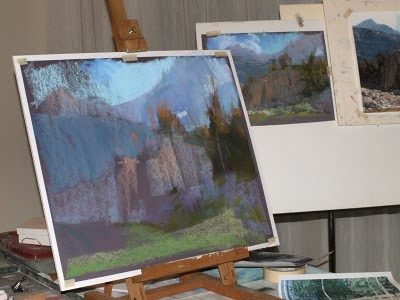
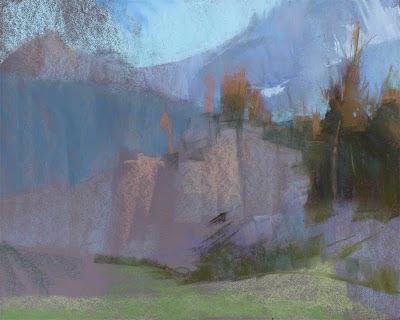
Here's the starting point. I'm working large (for me). This is a 17 x 21 sheet of Canson Twilight taped onto a piece of foam core. I have my field study and a reference photo off to the right. Working in the living room on a Saturday. I'm just laying in all the big shapes. A painting is a 2 dimensional pattern of value and color relationships, regardless of the subject, so my initial marks are just to cover all those areas with a basic foundation color and value. Basic proportions are judged relative to each other. Trying to avoid jumping into any one area, and just keep moving, but you can see I want to play around in the trees against the background on the right. There's some rich color and interesting edges up there.
Clearly started on the right, and headed left. Keep in mind pattern relationships are not necessarily object based, they are simply the major visible differences in the image... masses of things, shadow shapes, etc. These shapes and relationships form the underlying structure and composition of the final image.
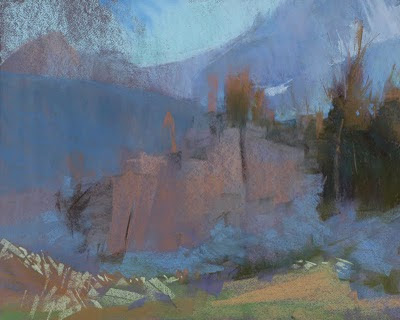
Continuing the journey to the left side of the image, but starting to work back into already established zones with the color I'm aiming for, pushing values and temperatures around, and refining edges. This is where a field study is invaluable, as opposed to only having a photograph. One's own color impressions and perceptions are often significantly different than what a camera is necessarily capable of recording. I usually reference my field study for the range of color, value, and my subjective impression of the experience, while the photo provides a more accurate reference for detail and placement of edges and forms.
It was fun to knock in the boulders on the lower left like a bunch dinosaur teeth. Most marks are kept pretty chunky, but I am starting to gradate color in the sky and the background peak that runs off to the right, as it moves towards the light. The upper left needs a cloud, and two layers of overlapping forms before I can justify more work in the foreground. Overall, I've probably put 90 minutes into the work, broken up into a few sessions over one afternoon and evening.
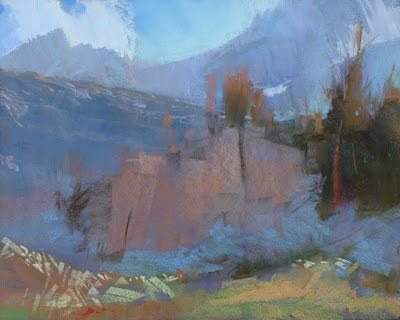
Sunday Session: It's raining out, I've got a Flemish pot roast burbling away in the other room, and the music is turned up. Olfactory and auditory sensations are good! Time to immerse. The upper left has been laid in...cloud, bg peak, and midground blue cliff all have some level of detail in the appropriate value and color range to keep it subordinate to the main contrasting zones of the image. I may make subtle adjustments and refinements to these areas, but they are pretty much done.
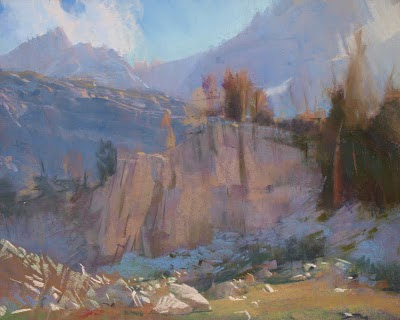
Monday Evening: I've got a cold, and am sneezing and dripping. You can see some evidence of that condition right at the horizon of the sky and the curving ridge above center. I've added warm light to the cloud and pushed the atmospheric light temperature on the upper right side of the image, behind the trees, and in front of the snow patch. The entire tree line has been indicated across the top of the cliff. At this point I've got the whole image up and running, and am now looking to balance and refine certain areas. At a glance, it can almost feel done, and the challenge from this point on is not to overwork it, but find a way of gracefully exiting the process after further resolving certain areas. The cliff is full of creases, crevices, and a range of differing temperatures on its faceted surface. Danger! The boulder field on the left needs to progress further, the cool talus slope below the cliff in shadow can use some more definition, as can the trees on the upper right. I again refer to my field study to see what I thought was important information when I was there, as the photo reference shows 'everything' in excruciating detail, and a far blander color scheme to boot. The lower right quadrant of the image has a level of loose handling, and luminous color relationships that I'm happy with, so I use that as a guide towards resolving the rest of the image.
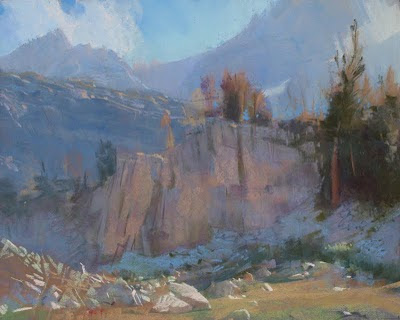2.sm.jpg)
About an hour later I've reached this point, and am feeling good enough to send a picture of it to the gallery. There's still more to go, but it is a careful dance of leaving out detail you know is there, but may not necessarily improve the image, or throw it out of balance. I've touched the meadow, the talus, the trees and the cliff, moving and adding color, levels of detail, and form description. Still need to remove the sneeze spots...
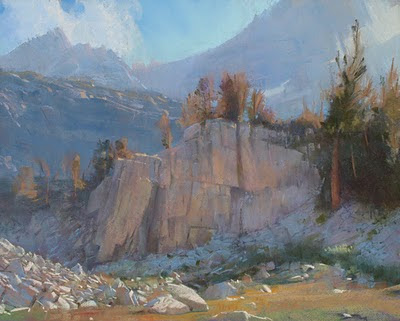
The High Country
16 x 20
Pastel on Canson Paper
My real job kept me busy the rest of the week, so I wrapped this up the following Saturday morning, working the lower left boulder field, the more distant cliff slope behind it, and readjusting color temperatures and contrast on the central cliff. I think I missed a bit of the earlier more luminous trees up top, but I at least managed to quit at this point.
I am doing some new work for a group show of Pixar artists at the Holton Studio in early December. As gallery owners and framers deserve to be kept in the loop when the clock is ticking down towards a show, I initially shot this to apprise Tim Holton of what was coming his way (and to assure him that I was actually working on something). Anyways, I took the opportunity to document the progress of this work, as much for my own curiosity as to to satisfy anyone else's interest.
The images below were taken over a week's time, some the same afternoon or evening. This is from a pastel study I did on my last Sierra trip in August to the Little Lakes Valley on the East side of the Sierra. Some notes on my process are given below each image. I should mention that I enjoy studying the game of chess, and a great part of that pleasure stems from reading over the annotated games of players, where they record their strategic ideas, plans, hopes and fears throughout the process of a game. There is a similar process in the creation of a painting, in my mind.


Here's the starting point. I'm working large (for me). This is a 17 x 21 sheet of Canson Twilight taped onto a piece of foam core. I have my field study and a reference photo off to the right. Working in the living room on a Saturday. I'm just laying in all the big shapes. A painting is a 2 dimensional pattern of value and color relationships, regardless of the subject, so my initial marks are just to cover all those areas with a basic foundation color and value. Basic proportions are judged relative to each other. Trying to avoid jumping into any one area, and just keep moving, but you can see I want to play around in the trees against the background on the right. There's some rich color and interesting edges up there.
Clearly started on the right, and headed left. Keep in mind pattern relationships are not necessarily object based, they are simply the major visible differences in the image... masses of things, shadow shapes, etc. These shapes and relationships form the underlying structure and composition of the final image.

Continuing the journey to the left side of the image, but starting to work back into already established zones with the color I'm aiming for, pushing values and temperatures around, and refining edges. This is where a field study is invaluable, as opposed to only having a photograph. One's own color impressions and perceptions are often significantly different than what a camera is necessarily capable of recording. I usually reference my field study for the range of color, value, and my subjective impression of the experience, while the photo provides a more accurate reference for detail and placement of edges and forms.
It was fun to knock in the boulders on the lower left like a bunch dinosaur teeth. Most marks are kept pretty chunky, but I am starting to gradate color in the sky and the background peak that runs off to the right, as it moves towards the light. The upper left needs a cloud, and two layers of overlapping forms before I can justify more work in the foreground. Overall, I've probably put 90 minutes into the work, broken up into a few sessions over one afternoon and evening.

Sunday Session: It's raining out, I've got a Flemish pot roast burbling away in the other room, and the music is turned up. Olfactory and auditory sensations are good! Time to immerse. The upper left has been laid in...cloud, bg peak, and midground blue cliff all have some level of detail in the appropriate value and color range to keep it subordinate to the main contrasting zones of the image. I may make subtle adjustments and refinements to these areas, but they are pretty much done.

Monday Evening: I've got a cold, and am sneezing and dripping. You can see some evidence of that condition right at the horizon of the sky and the curving ridge above center. I've added warm light to the cloud and pushed the atmospheric light temperature on the upper right side of the image, behind the trees, and in front of the snow patch. The entire tree line has been indicated across the top of the cliff. At this point I've got the whole image up and running, and am now looking to balance and refine certain areas. At a glance, it can almost feel done, and the challenge from this point on is not to overwork it, but find a way of gracefully exiting the process after further resolving certain areas. The cliff is full of creases, crevices, and a range of differing temperatures on its faceted surface. Danger! The boulder field on the left needs to progress further, the cool talus slope below the cliff in shadow can use some more definition, as can the trees on the upper right. I again refer to my field study to see what I thought was important information when I was there, as the photo reference shows 'everything' in excruciating detail, and a far blander color scheme to boot. The lower right quadrant of the image has a level of loose handling, and luminous color relationships that I'm happy with, so I use that as a guide towards resolving the rest of the image.
2.sm.jpg)
About an hour later I've reached this point, and am feeling good enough to send a picture of it to the gallery. There's still more to go, but it is a careful dance of leaving out detail you know is there, but may not necessarily improve the image, or throw it out of balance. I've touched the meadow, the talus, the trees and the cliff, moving and adding color, levels of detail, and form description. Still need to remove the sneeze spots...

The High Country
16 x 20
Pastel on Canson Paper
My real job kept me busy the rest of the week, so I wrapped this up the following Saturday morning, working the lower left boulder field, the more distant cliff slope behind it, and readjusting color temperatures and contrast on the central cliff. I think I missed a bit of the earlier more luminous trees up top, but I at least managed to quit at this point.
Labels:
Holton Studio,
Little Lakes Valley,
pastel landscape
David Ferrer at Miami Open 2010
Spanish tennis player David Ferrer is currently No. 8 in the world. Enjoy his shirtless pictures from Miami Open earlier this year.
Friday, October 29, 2010
Devon Sawa on Nikita s1e07
Devon Sawa is shirtless on the episode "Resistance" of Nikita. His chest is bruised but he's still hot!!
Wednesday, October 27, 2010
Jesse Williams on Greys Anatomy s7e04
Tuesday, October 26, 2010
Matt Lanter on 90210 s3e06
Matt Lanter is shirtless on the episode "How Much Is That Liam in The Window" of 90210. Yeah, how much is it?
Subscribe to:
Comments (Atom)














